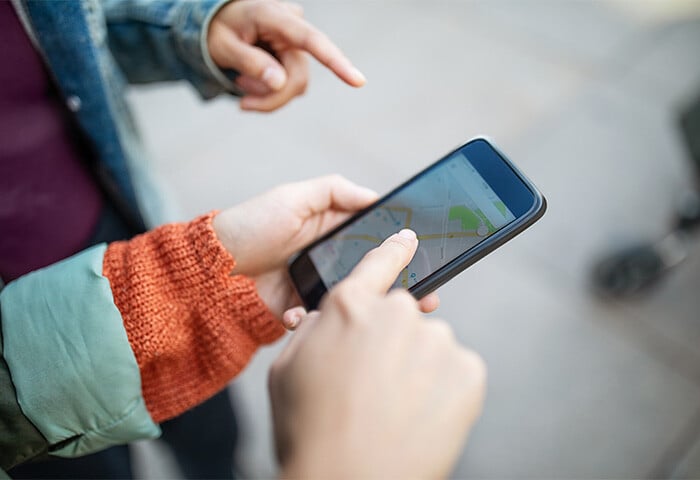What is an IP address?
An IP address (Internet Protocol address) is a series of numbers assigned to each device connected to a computer network or the internet. IP addresses identify and differentiate the billions of online devices, including computers and mobile phones, and help those devices communicate with one another.
Other devices connected to the internet — including printers and a growing number of Internet of Things (IoT) devices like smart speakers, refrigerators, home surveillance systems, and more — also have IP addresses.
IP addresses ensure that data transmission goes to the right location. Just like people and businesses need a home address to send and receive letters in the mail, internet devices need a digital address to send and receive data.
What can you do with an IP address? Pretty much everything online. IP addresses connect you to the websites you visit, the emails you open, and the videos you watch. All these activities connected to the internet are considered “data requests” and require an IP address. Your computer and internet service won’t work without IP addresses.
IP addresses broken down
IP addresses generally consist of four numbers ranging from 0 to 255, separated by periods. Within each IP address, you can see the network ID — assigned to your network by your ISP, and the host ID — the unique identifier assigned to each device connected to that specific network.
Let’s take a closer look and break it down. Here’s an IP address example:
172.16.254.1
Each of the four numbers in an IP address does not need to be a complete three-digit number. In the example above, the first number is 172, the second number is 16, the third number is 254, and the fourth number is 1. Together, this dotted-decimal format is called a 32-bit number.
Think of an IP address as a series of numbers and periods that behave similarly to a street address, so that your device can send and receive data from the internet.
Here’s another example of an IP address:
2001:db8:0:1234:0:567:8:1
This second example is a bit more complex — it’s what’s known as an IPv6 address. Why are there different types of IP addresses and why does IP address configuration vary so much? We’ll get into the different types of IP addresses and the roots of IPv4 and IPv6 a little later. But first, let’s examine the two key components of an IP address: the network ID and the host ID.
The network ID and the host ID
The network ID is the part of an IP address that identifies which network you’re using to connect to the internet (“172.16.254” in the first example above). The network ID is assigned by an internet service provider (ISP) if you’re connecting from home via a wireless router, by a company network if you’re connecting at work, and by a public network if you’re connecting at, say, a Starbucks.
A network can be as small as two computers connected to each other, or as large as the internet itself. The internet is a network. It’s a network of networks!
The host ID portion of an IP address indicates the particular device you’re using to connect to your network (it’s the “1” at the end in the first example above). Let’s say you have a bunch of devices at home, all of which require an IP address to connect to the internet. Their IP address configuration might look like this:
Device name: Network ID.Host ID
Laptop 1: 172.16.254.1
Laptop 2: 172.16.254.2
Desktop: 172.16.254.3
Smartphone: 172.16.254.4
Smartspeaker: 172.16.254.5
For each host (device) on a network, the network part of the IP address is the same, while the final number of the address is different because it identifies the different hosts. A host has only one IP address; a network has many.
The network ID combined with the host ID creates the IP address. Together, this string of alphanumeric characters lets you reach the internet.
 Example IP address of various devices connected to the same network.
Example IP address of various devices connected to the same network.
How IP addresses work
IP addresses work as unique identifiers for each online device, like a mailing address. Instead of getting physical mail, IP addresses ensure you get the data you request, such as search results, websites, and emails. Understanding how IP addresses work can help you make better decisions about online security and privacy.
To understand how IP addresses work, we first need to look at the basic definition of the internet. The internet is a global network of computers that function on the basis of protocols, or rules. These rules define how data is transmitted between electronic devices — in other words, the protocols determine how computers talk to one another over a network.
When you request something online, the internet “knows” where to send that request thanks to your IP address. When you type a search query like What is an IP address into Google, the internet retrieves that data (in this case, search results such as a link to this article) and sends it to your device.
All this happens instantaneously.
Why do we need IP addresses?
Computers need IP addresses to communicate with other online devices and networks. The purpose of IP addresses is to map the web and send data to the right place. Without this critical protocol address between devices and networks, the internet wouldn’t be able to fulfill your data requests.
IP addresses help organize the internet — which is why hiding, changing, and protecting your IP address is important. Without IP addresses, there would be no Facebook, no email, and no web browsing at all.
 You need an IP address to use social media, check your email, and browse the internet.
You need an IP address to use social media, check your email, and browse the internet.
What else does an IP address do besides behave as a digital home address for your device? An IP address can reveal sensitive information, like your physical location and other private details, and help companies track your online behavior. You can’t go online without an IP address, but you can change or hide it with a virtual private network like AVG Secure VPN.
A VPN encrypts your data and reroutes your online traffic through a dedicated VPN server before you connect to the public internet. Once you do connect to a website, you’ll appear to be coming from the VPN, so the site will see only the VPN’s IP address — masking your true IP address.
AVG Secure VPN has servers in tons of different countries to choose from, so you can opt to appear to be from almost anywhere. That’s helpful if you’re traveling and want to get the same access to streaming services that you enjoy in your home country. Protect your personal data, stay current with your favorite shows, and keep your online activity private with AVG Secure VPN.
Locating your own IP address
It’s simple to find your own IP address. The best way is by typing “What’s my IP address” into Google. Your IP address is displayed right there in the search results. The ease of finding your IP address is convenient, but it also shows how easy it is for hackers to find you online, too.
When you hide your IP address with a VPN, it’s much harder for snoops to find you online. Connect to a VPN and you can test it for yourself in a matter of seconds.
The different types of IP address
IP addresses vary depending on how devices are connected to the internet. A lot depends on where you’re connecting from (home, office, cafe) and the rules set up by your ISP.
Static and dynamic IP addresses
A static IP address (also called a dedicated IP address) is fixed, and doesn’t change automatically. Static IP addresses are commonly used for business devices, because having a dedicated IP address keeps network connections uninterrupted — helpful for conference calls and accessing servers when working remotely.
A dynamic IP address (also called a shared IP address) changes automatically based on available IPs. Dynamic IP addresses are usually used for devices connected to a home network, and require no manual input or setup. Dynamic IPs are assigned automatically and continuously by your ISP (Internet Service Provider).
Both static and dynamic IP addresses are assigned according to your specific network connections and device features. We’ll discuss more about how IP addresses are assigned below.
Public and private
Devices actually get two different IP addresses. Your computer has both a public IP address and a private IP address.
A public IP address, also called an external or global IP address, is used to communicate between hosts (devices) and the global internet. Public IP addresses, often provided for home use by your ISP, actually connect you to the internet.
A private IP address, often called a local or internal IP address, is assigned to your device from within a private network. Private IP addresses are not routed on the internet and are intended to work only within your local network.
Just as an office building might have a public address of 123 Main Street, Big City, USA, an office worker might have a private address of Room 123. Mail sent to this office worker will be addressed to the public address, and then an office manager (your ISP) will send it on to the private room.
Consumer
A consumer IP address refers to any IP address assigned to a business or individual that has an Internet Service Provider (ISP). Consumer IP addresses can be both public and private.
IPv4 and IPv6
Upon its conception, the internet was not what it is today. Its creators understandably did not foresee all the implications of global access and daily usage by billions of people and devices. Because of so many connected devices, North America actually ran out of IPv4 addresses. IPv4 is the original internet protocol numbering structure that works on a 32-bit numeric code.
This is what an IPv4 IP address looks like: 172.16.254.1
The difference between IPv4 and IPv6 addresses is that IPv6 addresses are the newest generation of IPs, created to deal with the shortage of IPv4 addresses. Written in a 128-bit hexadecimal format, with a range of numbers and letters and separated by colons, IPv6 addresses are (in theory) limitless.
This is what an IPv6 address looks like: 2001:db8:0:1234:0:567:8:1
The rollout of IPv6 is ongoing. Chances are you’re still connecting to the internet using an IPv4 connection. Currently, Google reports about 35% of users are connecting with an IPv6 address instead of IPv4. While adoption is steadily increasing, there may be a number of reasons why you would want to disable IPv6. The road to full usage may be bumpy.
TCP/IP
TCP/IP is the fundamental basis for IP addresses, but it’s not an IP address type itself. TCP/IP stands for Transmission Control Protocol/Internet Protocol and is a suite of protocols that make up internet architecture.
TCP/IP rules define how data is exchanged and communicated over the internet. The rules also specify how data is divided into packets and addressed in order to be transmitted, sent, and received at the final destination. Regardless of which IP address you’re using, it likely still follows the TCP/IP protocol.
How IP addresses are assigned
There are two types of IP address assignment: static or dynamic. How your device is assigned an IP address depends on your network, your ISP, and your device’s features.
Creating an IP address happens automatically if it’s dynamic, and manually if it’s static. A static address is fixed or permanent, while a dynamic address may change each time you connect to the internet. You may even be assigned a dynamic IP address every time you restart your computer.
Who or what assigns IP addresses varies based on your network connection. Broadly speaking, the world of IP addresses is managed globally by the Internet Assigned Numbers Authority (IANA), and then managed locally by your ISP, business administrator, or home router.
Keeping your IP address secure
Cybercriminals can do a lot of damage with just a little access. If your IP address is exposed, it can be a gateway for illegal and harmful activity. That’s why smart internet users often hide their IP addresses and access the internet securely using a VPN. You can also mask your IP using a proxy or Tor.
 A VPN creates a secure tunnel for your internet traffic.
A VPN creates a secure tunnel for your internet traffic.
Get AVG Secure VPN to create an airtight connection between your device and the internet and ensure your IP address stays hidden and protected.
Types of IP address security threats
Using a VPN lets you hide your IP address so you can avoid the risks involved from it being exposed.
Without a VPN to hide your real IP address, you could be vulnerable to a variety of security threats. Hackers might be able to:
 Access your device
Access your device
If hackers can access your IP traffic, your personal data (such as your banking and login information and your sensitive financial documents) could be exposed. Learn how to encrypt your sensitive data, or let a VPN do it for you.
 Download illegal content
Download illegal content
An increasing risk of unprotected IP addresses is replication by cybercriminals. Hackers can copy your IP address, then use it to access or download illegal content — which could then be traced back to you.
 Track your location
Track your location
Using a combination of IP addresses, GPS, Wi-Fi networks, and other systems, hackers can pinpoint your location. Using a VPN can help you cover your digital data trail.
 Stalk you
Stalk you
Shady characters might be able to take location tracking further and find your real home address based on your exposed IP address. A VPN changes your IP address location, disguising your real location and helping to protect you from identity theft.
 Attack your network
Attack your network
Cybercriminals can use your IP address to launch targeted DDoS attacks against your network, generating massive amounts of fake traffic with the aim of crashing a targeted website.
Keep your IP address away from prying eyes with AVG Secure VPN
Go online with a secure VPN to reap the benefits of digital anonymity. Not only does a VPN hide your IP address by letting you connect through a variety of VPN server locations around the world, it also encrypts your internet traffic. That means you can bank, shop, and browse without worrying about hackers or anyone else watching you.
AVG Secure VPN is your ticket to a safer and more private internet. Designed to hide your IP address and protect your anonymity no matter what device you use, AVG Secure VPN gives you instant access to military-grade encryption and streaming-optimized servers in over 50 locations around the globe. Give it a spin today, risk-free with our free trial.

 Example IP address of various devices connected to the same network.
Example IP address of various devices connected to the same network. You need an IP address to use social media, check your email, and browse the internet.
You need an IP address to use social media, check your email, and browse the internet. A VPN creates a secure tunnel for your internet traffic.
A VPN creates a secure tunnel for your internet traffic.





/Signal-What-is-TCP-IP-Thumb.jpg)
/Signal-Public-vs-local-IP-addresses-Thumb.jpg)
/IPv4-vs-IPv6--Thumb.jpg)



